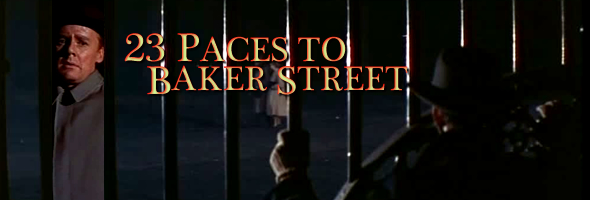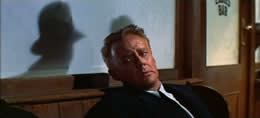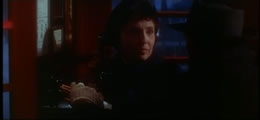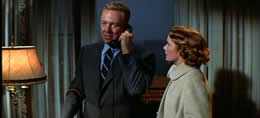
Color, 1956, 99m.
Directed by Henry Hathaway
Starring Van Johnson, Vera Miles, Cecil Parker, Patricia Laffan, Maurice Denham, Estelle Winwood
Odeon
(UK R2 PAL), A&R (Italy R2 PAL), Art House (Spain R2 PAL) / WS (2.55:1) (16:9)

Color, 1956, 99m.
Directed by Henry Hathaway
Starring Van Johnson, Vera Miles, Cecil Parker, Patricia Laffan, Maurice Denham, Estelle Winwood
Odeon
(UK R2 PAL), A&R (Italy R2 PAL), Art House (Spain R2 PAL) / WS (2.55:1) (16:9)
 One of the many prestige Hollywood suspense films turned out during Alfred Hitchcock's heyday in the 1950s and early 1960s, 23 Paces to Baker Street (which has nothing to do with Sherlock Holmes) is still surprisingly unsung but now stands as one of the most influential among such other superior efforts as Midnight Lace and Charade. This time our everyman hero is Philip Hannon (Johnson), a playwright whose recent blindness has dampened his enthusiasm
One of the many prestige Hollywood suspense films turned out during Alfred Hitchcock's heyday in the 1950s and early 1960s, 23 Paces to Baker Street (which has nothing to do with Sherlock Holmes) is still surprisingly unsung but now stands as one of the most influential among such other superior efforts as Midnight Lace and Charade. This time our everyman hero is Philip Hannon (Johnson), a playwright whose recent blindness has dampened his enthusiasm over having a hit play; even worse, it ruined his engagement to Jean (Miles), who decides to drop by anyway to say hello while he's writing a new play in London. Philip rebuffs her and goes out for a drink at the local pub, the Eagle, where he overhears two people -- one with a strange, sinister voice -- plotting what sounds like something very criminal indeed on the other side of a lounge wall. Unable to actually see the conspirators, he believes he's heard plans for a kidnapping and enlists Jean and his manservant, Bob (Parker), into helping him get to the bottom of the mystery when the police prove completely unhelpful.
over having a hit play; even worse, it ruined his engagement to Jean (Miles), who decides to drop by anyway to say hello while he's writing a new play in London. Philip rebuffs her and goes out for a drink at the local pub, the Eagle, where he overhears two people -- one with a strange, sinister voice -- plotting what sounds like something very criminal indeed on the other side of a lounge wall. Unable to actually see the conspirators, he believes he's heard plans for a kidnapping and enlists Jean and his manservant, Bob (Parker), into helping him get to the bottom of the mystery when the police prove completely unhelpful.
An atmospheric portrait of postwar London as well as an engrossing thriller, 23 Paces to Baker Street has been treated with strange indifference by Fox, who have shown little interest in releasing it on video in America while other companies have licensed it out in Europe. (Some bootleg DVDs are floating around out there, but those are best avoided.) That's especially odd considering how much it actually inspired later films, most notably the classic shocker Wait Until Dark (whose 1966 source play has a very similar light-smashing climax) and the earliest wave of Italian gialli, with its gloved, fedora-wearing murderer stalking the trapped hero alone in a dark apartment at night. The unmasking of the killer also feels very giallo in more ways than one, though to say more would be a major spoiler. The shadowy photography of this sequence is still striking today along with earlier ones involving a murder in a fog-shrouded phone booth and a later attempt in which Johnson is sneakily left atop an unfinished building at night to nearly plunge to his death; fans of everything from Blood and Black Lace to The Card Player shouldn't have much trouble seeing those films' stylistic ancestor here. Of course, the central gimmick of a blind eyewitness trying to piece together what he's heard also foreshadows Dario Argento's The Cat o' Nine Tails, which probably wouldn't exist without this film. The mystery itself really isn't anything terribly special (and doesn't quite hold up to scrutiny if you think about it), but there are some reasonably odd twists and turns along the way as Johnson and company unravel the crazy plot threads.
Thoug h not a major auteur, director Henry Hathaway certainly knew his way around a darkened street thanks to his work on such noirs as Kiss of Death, Call Northside 777, and Niagara, while here he gets to play around with Fox's beloved CinemaScope format in all its super-wide glory. Naturally that means plenty of shots of the Thames, foggy streets, and colorful pub interiors, while busy composer Leigh Harline (7 Faces of Dr. Lao) offers a restrained string-laden score. The film was actually based on a 1938 mystery novel by Philip MacDonald (author of The List of Adrian Messenger), originally filmed in 1938 under its original title, The Nursemaid who Disappeared (though the book was also printed as Warrant for X). However, the book's whodunit aspects have been largely stripped away, even ditching the central detective character entirely to let the witness do all the snooping himself. Whether the gambit works will be up to each mystery fan's taste, but for movie buffs, it's a fascinating film indeed.
h not a major auteur, director Henry Hathaway certainly knew his way around a darkened street thanks to his work on such noirs as Kiss of Death, Call Northside 777, and Niagara, while here he gets to play around with Fox's beloved CinemaScope format in all its super-wide glory. Naturally that means plenty of shots of the Thames, foggy streets, and colorful pub interiors, while busy composer Leigh Harline (7 Faces of Dr. Lao) offers a restrained string-laden score. The film was actually based on a 1938 mystery novel by Philip MacDonald (author of The List of Adrian Messenger), originally filmed in 1938 under its original title, The Nursemaid who Disappeared (though the book was also printed as Warrant for X). However, the book's whodunit aspects have been largely stripped away, even ditching the central detective character entirely to let the witness do all the snooping himself. Whether the gambit works will be up to each mystery fan's taste, but for movie buffs, it's a fascinating film indeed.
The 2012 movie-only DVD release from Odeon (under its Hollywood Classics brand) is easily the widest and most accessible version out there, offering a super wide 2.55:1 transfer that bests the sickly-looking transfer that occasionally pops up on TV, usually the Fox Movie Channel. As with its companion films from the same period, this one has a definite case of the CinemaScope mumps as the Bausch & Lomb lenses tended to squash out actors' faces in close ups; that's just something that comes with the territory, as anyone who's seen titles like The Girl in the Red Velvet Swing or The Robe can attest. It isn't the sharpest-looking film in the world by a long shot, but for a '50s Fox scope title, it looks pretty respectable for what it is. It would be a pleasant shock if someone like Twilight Time decided to revisit this one for HD down the road (and how much better it could look is anyone's guess), but for thriller fans, this makes for a satisfying and very cheap viewing option.
![]()